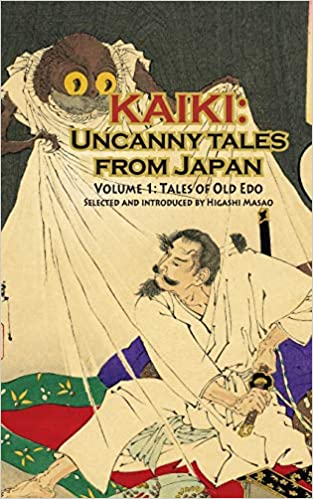Edited By HIGASHI MASAO (Kurodahan Press; 2009)
This anthology, the first of three volumes, is a terrific collection of Japanese supernatural tales set during (though not always from) Japan’s Edo period of 1603-1868. Japanese genre fiction is largely unrepresented in English, and this book provides a taste of what we’ve been missing out on (plus it’s also a good companion piece to DREAM SPECTRES, Creation Press’ excellent study of ukiyo-e art of the period).
A lengthy introduction by Higashi Masao outlines the history of Japan’s supernatural tradition, and fills us in on the backgrounds of the stories selected. Those selections, I might add, are extremely well translated by a variety of authors, proving that (contrary to many of the Japanese translations I’ve read thus far) Japanese prose does not have to be rendered in kiddie book English!
Among the authors represented here is the immortal Lafcadio Hearn, with the 1902 “In a Cup of Tea” (from Hearn’s masterpiece KWAIDAN), a quietly startling tale of what occurs when a man drinks the soul of another. Also included is a transcription of an 1898 lecture Hearn gave about the value of supernatural fiction. He concludes that such writing is greatly undervalued by the mainstream literary establishment yet is a vital and profound branch of literature, and that the best supernatural tales are inspired by dreams.
Dreams would definitely seem to be the inception behind many of the odder tales of this collection. Notable examples include Kyogoku Natsuhiko’s “Where Had She Been?,” a 16th Century set account of a servant girl’s inexplicable disappearance and even more inexplicable reappearance, and Inagaki Taruho’s “The Ino Residence, or, The Competition With A Ghost,” a 1972 updating of an old story about a young samurai who becomes the target of all manner of supernatural insanity. Both tales are distinguished by a rational, almost matter-of-fact acceptance of supernatural phenomena in the midst of everyday life, although to most Western readers the time and setting will seem quite alien. Particularly odd is “The Ino Residence,” which contains everything from a severed head appearing on the protagonist’s chest to slowly lowering ceilings to a room filled with gluey goo, all related with an unnerving calmness.
Koda Rohan’s 1938 “Visions from Beyond” takes the normalcy-inverted concept even farther. It’s a ghostly tale that involves fishing, which the author describes in such exacting detail that it’s unclear whether we’re reading a ghost story with a fishing backdrop or a fishing story with ghostly elements. It’s a fascinating tale either way, and unlike any Western ghost story I’ve ever read.
A ghostly tale of an altogether different stripe is provided by Miyabe Miyuki’s “Futon Room” (2000), a suspenseful and hallucinatory account of what occurs when a young housemaid is ordered by her employer to sleep in the foreboding room of the title. “Three Eerie Tales of Dark Nights” by Sugiura Hinako is a brief manga tale that concludes the volume. It’s an intense evocation of a man walking at night, and why it’s not a good idea to do that when two moons appear in the sky, as happens here. Of course the tale’s protagonist fails to heed that advice, and pays the price in a succession of a surreal and horrific encounters.
Yes, there’s something for everybody in this eclectic and unprecedented collection. I look forward to the upcoming volumes.

